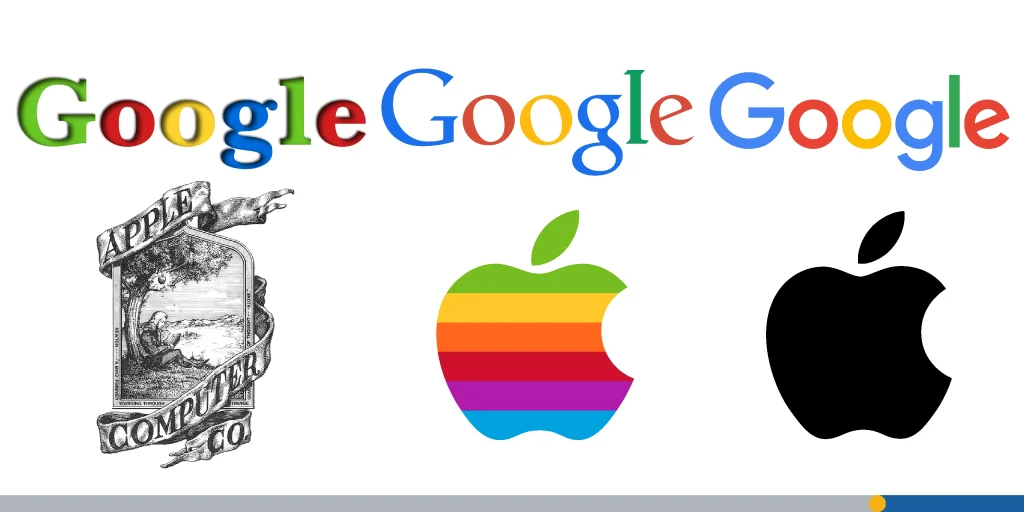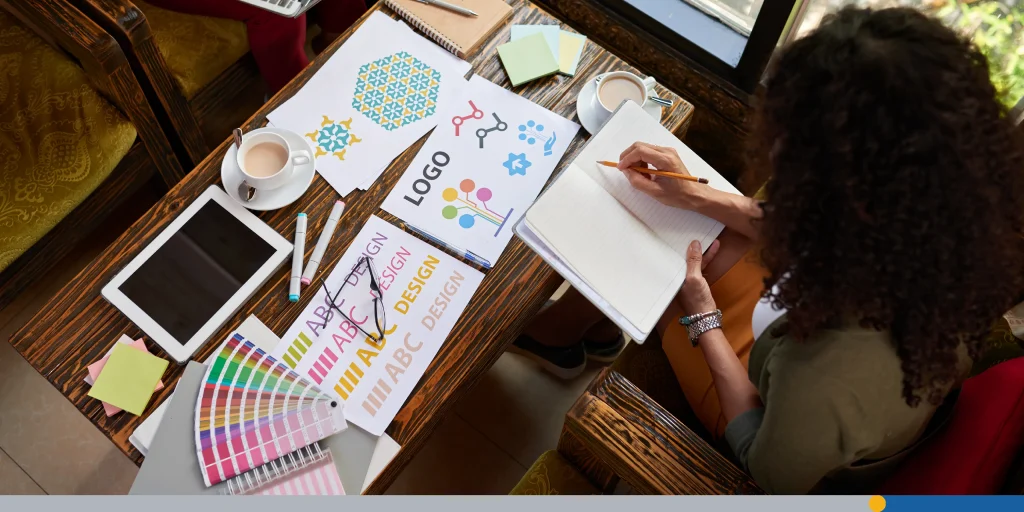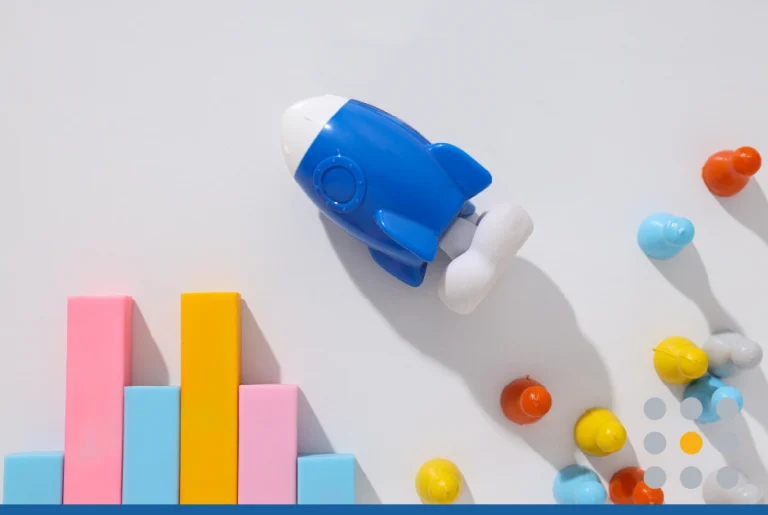Every business, whether big or small, is continually evolving to keep pace with market changes, shifting consumer needs, and evolving industry trends. As your company grows, so should your brand, often starting with your logo design.
After all, your logo is the very first thing your customers notice. It’s your company’s face and the symbol of your brand story. But what happens when your existing logo no longer feels like it represents who you are, what you do, or where you’re headed?
In this article, we will dive into when and why it might be the right time to consider a logo redesign, explore the steps involved in a successful rebranding, and address how to approach the decision-making process.
- What Is Logo Rebranding?
- When to Consider a Logo Redesign
- How to Rebrand: The Logo Rebranding Process
- Best Practices for Logo Rebranding
- Unlocking Marketing Opportunities Through Logo Redesign

What Is Logo Rebranding?
Logo rebranding is a strategic process where a company changes or updates its logo design to better reflect its current identity, values, and business objectives. This process is more common than you’d imagine. 74% of the S&P 100 companies have rebranded their business in the first seven years. Rebranding is a natural step in the evolution of any successful business.
Now you might think that a rebrand is all about aesthetics, but it’s about much more than that. A rebrand is about clarifying your brand mission, evolving your brand story, and ensuring it resonates with your target audience.
A redesigned logo is a huge part of a successful rebrand. It can give your company a fresh start, making it more relevant in today’s market, and drive a deeper connection with existing customers while attracting a new audience.
When to Consider a Logo Redesign
A logo redesign doesn’t happen overnight, and it’s important to carefully evaluate whether it’s the right time for your company.
Let’s explore some common scenarios that may indicate it’s time for a rebranding effort.
Outgrowing Your Original Logo
Many companies start with a simple original logo—something that works at the beginning but may not hold up as the business grows. As your company expands, so should your logo. If your old logo feels outdated or no longer reflects your company’s evolving identity, it may be time to reassess.
Example: Old Spice
Old Spice’s old logo was an anchor to its nostalgic past, but when it needed to appeal to a younger audience, it went for a complete rebranding, featuring an updated logo and an innovative marketing campaign.
The result? People started talking, and the company had a major resurgence in popularity.
Change in Company Direction or Market
If your company has undergone a complete overhaul—whether through a shift in product offerings, mergers, or changing your brand mission—your logo might need an update to reflect this new direction. A change in your target customers or a new market focus could also warrant a logo refresh.
Example: Slack
Slack originally started as a gaming company but evolved into a messaging platform for businesses. Their logo redesign helped signal this major shift to the world. Similarly, if your company has taken on a new brand story or brand strategy, your logo should reflect those changes to ensure consistency across all platforms.
Your Logo No Longer Connects with Your Audience
If your logo fails to connect emotionally with your target audience, it might be time for a change. A logo that once appealed to a younger demographic might not have the same effect on your current target customers.
For instance, if your business has grown and now serves a more professional or upscale market, you might need a professional logo design that aligns with this new customer base.
Example: Airbnb
A great example of this is Airbnb, which revamped its logo in 2014, debuting the “Bélo,” which symbolizes belonging and represents the company’s mission to make travelers feel at home anywhere. The new brand logo struck an emotional chord, signalling the company’s evolution from a simple booking platform to a global community-focused brand.
Keeping Up with Industry Trends
Even if your logo was perfect a few years ago, it might not look as fresh today. Logos and brand guidelines evolve as design trends change. If your existing logo looks outdated compared to your competitors, it’s time for a logo redesign. You don’t need to follow trends for the sake of it, but you also don’t want to be left behind in a world where design can significantly impact brand recognition.

Example: Google & Apple
Look at tech giants like Google or Apple—they’ve all gone through rebranding efforts to stay relevant and modernize their logos. It’s not about completely abandoning the old logo; it’s about updating it in a way that feels new while maintaining the essence of the brand.
A New Company Name or Product Launch
If your company is undergoing a name change or launching a new product line, a new logo is often part of the rebranding process. A new brand requires a new visual identity—something that aligns with your updated brand story and mission. Similarly, when companies merge or acquire others, the newly formed entity often opts for a fresh logo to symbolize the combination of brands and their unified vision.
Example: T-Mobile
A great example is T-Mobile’s subtle logo redesign in 2020, which reflected their new brand identity after their merger with Sprint. The new logo is very similar to the 2013 logo, but the magenta color is darker, the wordmark is bolder, and the dotted line was shortened to two dots instead of five. The streamlined and minimalist approach reflects the company’s evolution and expansion.
To Stay Ahead of Competitors
As the market changes, new competitors may emerge. If your current logo is too similar to that of a competitor or doesn’t adequately differentiate you, you risk blending into the background. A redesigned logo can help position your company as a leader in your field, ensuring that you maintain valuable brand recognition in your industry.
Example: Pepsi
When Pepsi revamped its logo over the years, it was often in an attempt to stand out amongst competitors, namely Coca-Cola, which has had minimal logo redesigns during its history. Pepsi made subtle tweaks to create a modern logo that still maintained its recognizable brand image.

How to Rebrand: The Logo Rebranding Process
While there is no one-size-fits-all strategy for rebranding, there are some common processes that work for most companies.
Here’s a step-by-step breakdown of how the logo redesign process typically unfolds.
Step 1: Brand Audit
Before diving into logo design, you need to conduct a thorough brand audit. This involves evaluating your company’s current brand identity, analyzing competitor logos, and gathering insights from market research. A brand audit helps identify what’s working and what isn’t, providing a roadmap for your redesign.
Step 2: Defining Your Brand Strategy
The next step is defining your brand strategy. What are your brand’s mission, values, and goals? What does your brand story communicate, and who is your target audience? These insights will inform the logo design process, ensuring the logo accurately represents your company’s essence.
Step 3: Collaborate with a Design Team
A good design team will help bring your vision to life. Whether you work with an in-house team or a design agency, ensure they understand your brand goals and the direction you want to take with your new logo. It’s essential to collaborate with professionals who can create a logo that’s both visually striking and meaningful.
Note: Many small businesses lack the resources to hire a dedicated design team; this is where FreeLogoServices comes in! FreeLogoServices offers an easy-to-use logo design tool that allows you to create an amazing logo with no prior experience required. Additionally, if you do want to consult a professional designer, you have the option to work with a hand-picked logo designer at an affordable rate.
Step 4: Design & Refine
This is the fun part! Once you’ve chosen a direction, start designing your new logo and refine it as you go. FreeLogoServices’ logo maker allows you to make as many edits to your logo as you want. Tweak the color palette, play around with different fonts, and perfect the design until it aligns perfectly with your new visual identity.
Step 5: Testing & Feedback
Before officially launching your redesigned logo, it’s crucial to test it with existing customers and gather feedback. Does the logo resonate with your audience? Does it communicate the right message? This feedback loop will ensure your logo is ready for the world.
Step 6: Launch the New Logo
Once you’re happy with the design, it’s time to launch your new logo design. Announce the logo redesign with a brand refresh campaign to let your customers know about the change. Be sure to update all marketing materials, including your website, social media profiles, and promotional items like business cards, to reflect the new look.

Best Practices for Logo Rebranding
A logo redesign isn’t always smooth sailing. Without the right approach, your rebranding efforts could backfire, leaving existing customers confused or even alienated. For example, in 2023, the streaming service HBO Max changed its name to simply Max. This lead to a great deal of confusion for customers who were unsure what the new service actually was.
To help avoid any problems that might arise with a rebrand, we’ll outline some best practices that every company should follow when introducing a new logo design.
Develop Clear Brand Guidelines
Once your redesigned logo is ready, the next step is creating comprehensive brand guidelines. This ensures that your new design isn’t used inconsistently across different platforms, teams, or marketing materials.
Your brand guidelines should include:
- Clear logo usage rules (size, spacing, positioning)
- Your new color palette
- Approved typography and fonts
- Visual do’s and don’ts
- Imagery style and tone of voice
Consistency is the secret sauce that makes your brand instantly recognizable. Whether someone is scrolling on Instagram, receiving an email, or walking by your storefront, they should get the same cohesive brand experience. A sloppy rollout can weaken your brand equity, so get your guidelines in place early.
Manage Consumer Confusion Proactively
One of the biggest hurdles in any rebranding process is addressing the reaction from existing customers. People naturally resist change, and if they feel like your new logo is unfamiliar or inconsistent with the brand they know and love, confusion—and even backlash—can follow.
The best approach? Over-communicate.
Here’s how to keep customers in the loop:
- Announce the change before it happens, not after.
- Share the “why” behind your logo redesign.
- Use social media, email newsletters, and blog posts to tell your brand story and bring your customers along for the ride.
Make it about them. Help them feel like part of the evolution, not outsiders looking in.
Create a Seamless Transition Plan
Consistency is crucial—but so is timing. Avoid launching a new logo in a piecemeal way. Instead, aim for a coordinated launch that rolls out across your website, packaging, signage, emails, social media, advertising, and any other touchpoints your target audience interacts with.
It should feel like a fresh start, not a fragmented identity crisis. Your marketing team should prepare all assets and schedule releases ahead of time. A clear timeline ensures your company’s branding remains unified from day one of the relaunch.
Evaluate & Adapt Post-Launch
Once the dust settles after your logo refresh, the work isn’t over. Monitor how your target customers and existing customers respond.
Look for data points such as:
- Customer feedback and comments
- Website traffic and bounce rates
- Social media engagement
- Sales or sign-up activity post-launch
If something’s not landing well, don’t panic. Minor tweaks are often expected. This phase is all about fine-tuning, learning, and continuing to build a brand that’s not only visually appealing but also emotionally resonant.

Unlocking Marketing Opportunities Through Logo Redesign
A logo redesign can be a marketing goldmine. When done right, it gives your brand a chance to make noise, turn heads, and reintroduce itself to the world with renewed purpose.
In fact, some of the most successful rebranding efforts use the launch of a new logo as a springboard for storytelling, customer engagement, and even increased sales.
Here’s how you can take advantage of the marketing power behind your fresh new look.
- Create a buzz-worthy launch campaign: Use your redesigned logo as the focal point of a well-thought-out campaign that builds anticipation and sparks curiosity. Tease parts of the new logo design on social media, create a countdown to your official launch day, and share behind-the-scenes videos of your rebranding process.
- Reintroduce your brand mission and vision: Use your marketing channels—email newsletters, blog posts, press releases, video content—to share your brand mission and how it’s evolved, as well as your vision for the future.
- Boost brand awareness with fresh visuals: With a modern logo comes a whole new color palette, updated imagery, and revitalized messaging. This fresh set of assets can breathe new life into all your marketing materials—from digital ads to product packaging.
- Create limited-time promotions around the new logo: Tie in your logo refresh with a limited-time promotion such as exclusive merchandise featuring the new logo design, discount codes to celebrate the new look, and contests encouraging followers to share their favorite version of your brand logo over the years.
- Spark conversations and media coverage: Rebrands get attention, especially from industry publications, design communities, influencers, and the press. If you handle your logo redesign with intention and creativity, you have a strong chance of gaining media coverage, which can lead to increased visibility and new followers.
- Use it as a catalyst for a bigger brand refresh: Sometimes, a logo redesign is just the beginning. It can be the launchpad for an entire brand refresh—from messaging and packaging to your marketing strategy and customer experience.
Conclusion
Your brand logo should reflect your company’s identity, values, and mission. If your logo is not performing as you would like, it may be time for a logo redesign. While the rebranding process can seem daunting, it presents a great opportunity to reimagine how your brand is perceived and experienced by your customers.
A rebranding effort can give your business the fresh start it needs, while building stronger connections with both existing customers and a new audience.
If you’re looking to redesign your logo, FreeLogoServices‘ intuitive logo maker offers thousands of fully customizable logo templates to help you create an amazing new logo in just a few minutes!
FREQUENTLY ASKED QUESTIONS
How do I know if I need a logo redesign?
If your existing logo feels outdated, doesn’t resonate with your audience, or no longer reflects your company’s evolution, it’s time to consider a redesign. A logo redesign is also essential if you’re shifting your brand mission, merging with another company, or expanding into new markets.
Can I update my logo without changing my brand identity?
Yes. A logo refresh can update the look of your logo without drastically changing your brand identity. You can tweak elements like color, typography, or design to modernize the logo while still maintaining the core elements that represent your brand.
How long does the logo redesign process take?
The rebranding process can take anywhere from a few weeks to several months, depending on the complexity of the redesign and the feedback loop. Make sure to allow enough time to thoroughly test and refine the design.
Do I need to change everything if I redesign my logo?
Not necessarily. You may only need to update the visual identity, such as changing the color palette or typography, while keeping the overall feel of the original logo. However, a complete overhaul may be necessary if your company has drastically shifted direction.
Will a new logo help improve brand recognition?
A well-designed logo that aligns with your brand story and resonates with your target audience can significantly boost your brand recognition. It creates a memorable visual identity that sets you apart from competitors.






